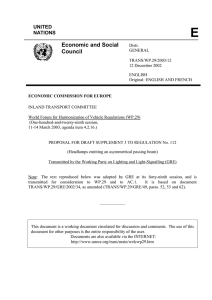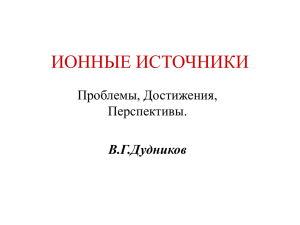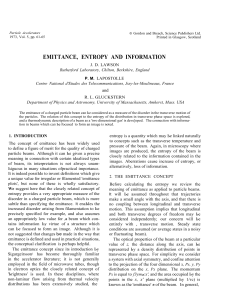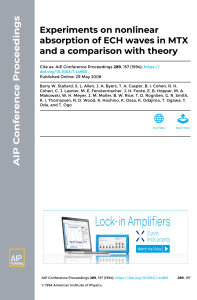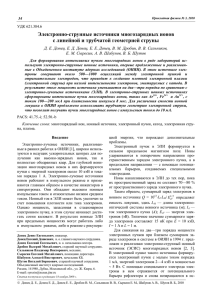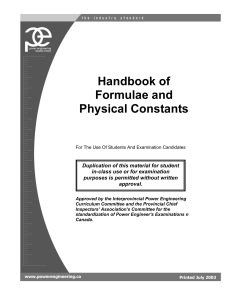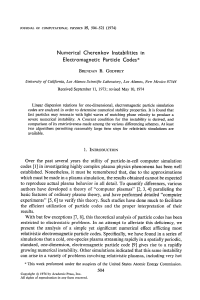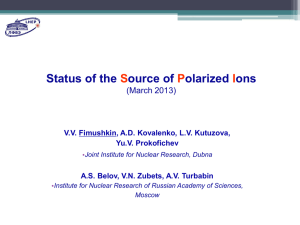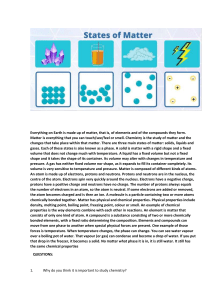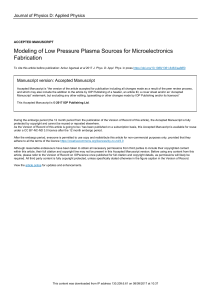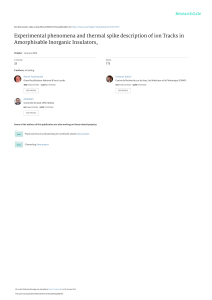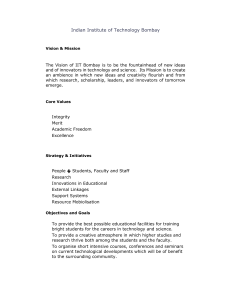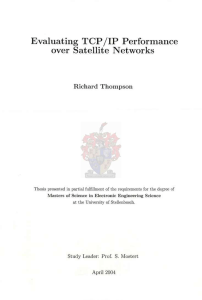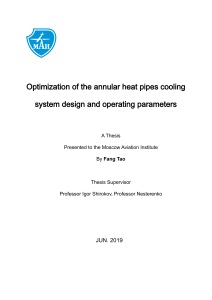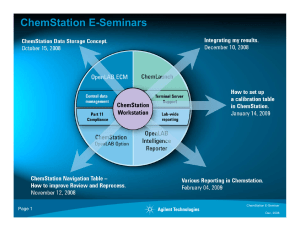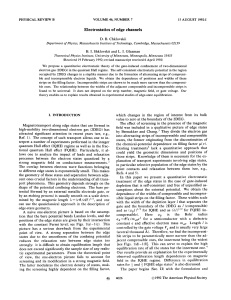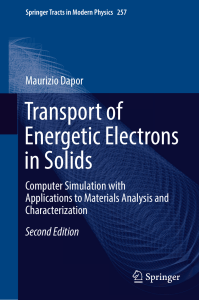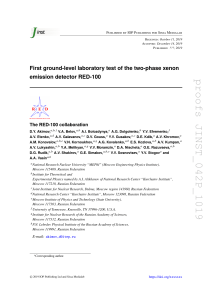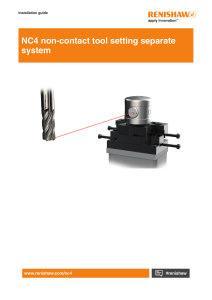Unsolved problems at the dynamic of the cooled beams охлаждённых пучков
advertisement

Открытые вопросы в динамике охлаждённых пучков Unsolved problems at the dynamic of the cooled beams IX Международный семинар по проблемам ускорителей заряженных частиц памяти В.П.Саранцева, 17 - 21 сентября 2011, Алушта, Украина Пархомчук В.В. ИЯФ СОРАН, Новосибирск Coolers photo: The electron cooling experiments was made at this coolers and will used for discussion at this report NAP-M storage ring pioneer of the storage rings with electron cooling CELSIUS cooler CSRe cooler LEIR cooler CSRm cooler Cooling sections Exit Ion beam incoming Ion beam Coherent dumping 4re ri ne c max 1 ln( ) 3 (V / c) min Single particle cooling rate 2 Zi ri rp Ai N 1 * N The cooling rate of the fluctuation with N number of ion. cooling time single ion 1 sec cooling time for micro bunch with N=1.0E6 1 micro sec. Sketch of Mg jet profile meter Measuring the ion beam density at the center of beam versus time. Initially high (but negative) signal of cooled beam after kick close to 0 signal of wide profile and then cooling with returning to almost the same density Without cooling linear increasing radius of the ion beam proportional of the amplitude of the kicker voltage/ But with the electron cooling on the radius after kick few times less! For small proton current the amplitude return to value close to radius without cooling Влияние протонного тока на амплитуду раскачки после удара инфлектором 5 кВ. Протонный ток именялся от 55 мкА до, примерно, 1 мкА, а амплитуда от 2 мм до 5 мм. 5 10 4 5 10 5 10 4 4 0 vxnt j 0 vxnt j 5 10 0 vxnt j 4 5 10 1 0.5 0 0.5 5 10 4 4 1 xnt j 1 0.5 0 0.5 1 1 0.5 0 xnt j 5 10 0.5 1 xnt j 4 5 10 4 0 vxnt j 0 vxnt j 5 10 4 5 10 1 0.5 0 xnt j 0.5 4 1 1.5 1 0.5 0 0.5 1 xnt j The phase space the ion beam after coherent kick. We can see the de coherent motion with decay average <x> and <vx> signal. Landay damping 1 Eck 0.5 0 0 0.001 0.002 0.003 k f0 10 0.004 0.005 Coherent emitanse versus turns single particle (average) emittance 1.2 1 1 0.8 Dk 1 Dk 2 D1k 1 0.8 D1k 2 D2k 1 D2k 2 0.6 D3k 1 0.6 D3k 2 D4k 1 D4k 2 D5k 1 0.4 D5k 2 0.4 0.2 0.2 0 0 0 200 400 600 nturnk dec=0 dec=0.001 dec=0.002 dec=0.004 dec=0.01 dec=0.02 800 1000 1200 0 200 400 600 800 1000 nturnk dec=0 dec=0.001 dec=0.002 dec=0.004 dec=0.01 dec=0.02 Coherent motion emittance decreased by mixing without coherent damping Single particle emittance are constant But if coherent motion are cooled faster then mixing the rest single particle emittance decreased. 1200 The fast electron beam energy modulation increased momentum spread of ion beam and the ion beam radius increased by more fast decoherence the ions oscillations. For Амплитуда колебаний в зависимости от амплитуды модуляции продольной скорости электронного пучка. Ep=65 MeV, Je=400 mA. The intensity of the proton beam versus time with cooling and without cooling. As easy to see the first stage decay not change exist cooling or not exist (detune energy electron beam). Proton beam current (mA) 10 CELSIUS (1998) Je=200mA, Ue=25 kV high intensity middle low 1 0,1 0,01 1E-3 0 10 20 30 40 50 time (s) But decreasing initial intensity ion beam lead to absent initial fast decay.. LEIR accumulation Pb+54 Positive influence the ion beam Inteancity. More intensive ion beam cooled faster. Initial hot ion beam after mixion with coled ion beam becames by Intra Beam Scatering more cool and more easy cooled by the electron cooling At figure time increase down and between marks interval 1 s. The horizontaly the ion beam aperture 50 mm. Red painting is the electon beam profile for coolong. 3.341 4 The bunching carbon beam at CSRe After injection on energy 200 MeV/u. Initially un bunching beam produce A many small micro bunches together with Forming main bunch. signal from pickup V 3 yk j 2 1 0.1 0 0 0 0.2 0.4 0.6 kdt time usec 0.8 1 1.2 1.022 Рис.7. Прямое наблюдение сигналов на пикапе при группировке 200 МэВ/н при электронном охлаждении. Показаны первые 700 сек охлаждения, во время которых наблюдаются образование нескольких паразитных сгустков и довольно быстрые потери пучка. The history of the bunched electron cooling 200 MeV/u carbon beam at CSRe. At initial moomnt we can see fast decay intensity. But after decrease peak current 2.5 mA the life times increased up to 1000 sec. At initial cooling clear see micro structure of the ion beam current But after final cooling all parasitic bunches disappeared. Maximal peak current near 3 mA. Clear see the tail of the ion bunch. The intensity of the ion beam high for strong compensation accelerated RF field. Ion beam current (A) 100V 200V 100 400V 0 100 200 300 400 Time (s) Working with detune (partially) Electron beam date was sended to me The pulse width is 10ms. The intervals related to left and right panel are 80ms and From IMP Lanzow colleges 11 Sept. 100ms, respectively.” The ion beam intensity vs. time for the pulse height of 100V (best lifetime), 200V and 400V (worst lifetime), respectively. The pulse width is 20ms and the interval between two pulses is 100ms. The vertical axis is logarithmic. The dash line connected the beginning and the end of the data for the pulse height of 400V is for reference. d 2 xi Z e Ep, 2 Mi dt The plasma model of the electron cooling Coherent oscillation d 2 xe e Ep, 2 mi dt E p 4e(nn xe ni xi ) e2i2 e2i2 | A | 1 2 (1 cos( p ) sin( p ) p4 3p Заключение Как показывают многочисленные измерения пучков с электронным охлаждением, эффекты интенсивности могут существенно улучшить или ухудшить свойства ионного пучка. При использовании электронного охлаждения очень важно иметь это в виду и стараться создавать условия, когда эти особенности помогают решить поставленную задачу. Взаимодействие ионного и электронного пучков еще плохо изучено с точки зрения когерентной устойчивости и ждет приложения усилий для дальнейшего развития методов охлаждения.
